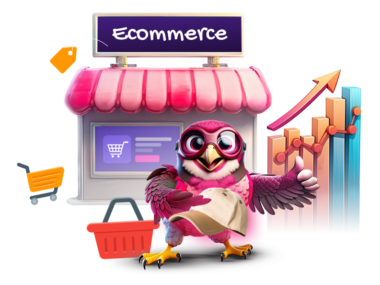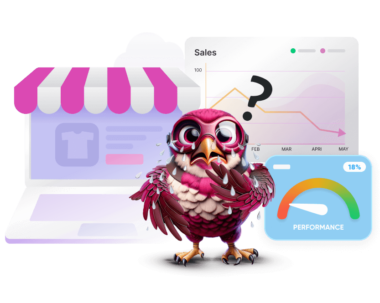E-commerce is booming. Last year, online sales reached an astounding $5.8 trillion, with projections indicating further expansion to over $8 trillion by 2027.
This rapid growth has redefined the competitive landscape, particularly among the industry giants Alibaba and Amazon. And while Alibaba holds a significant lead with nearly a quarter of the market share, Amazon isn’t trailing too far behind with projected sales expected to reach $1.2 trillion in the near future.
So, as we head into Black Friday & Cyber Monday 2024, the stakes have never been higher. For many brands, this could be a critical opportunity to excel – or risk falling behind. The question is: Are you prepared to capitalise on this moment? What e-commerce strategies do you have that will differentiate your brand and ensure success during this pivotal holiday season? What’s the next viral product to sell, and in which market?
These and a lot more questions are critical to answer as you step into the thick of the holiday sales season. And at Rapyd Cloud, we’re not just about providing a Hyperspeed hosting for dynamic websites; we also provide in-depth insights to help our users and readers understand what truly matters for their success.
So here’s a comprehensive look into the E-commerce trends and predictions for Black Friday 2024 and other insights that will help you create a strong holiday strategy.
Key Takeaways
- E-commerce sales are surging – and are projected to reach over $8 trillion by 2027.
- Smartphones are expected to account for 62% of e-commerce sales – and social platforms like Instagram and TikTok are driving significant sales growth.
- Direct-to-consumer (DTC) models and eco-friendly products are increasingly popular.
- AI personalisation, BNPL options, and chatbot support are enhancing customer experience and conversions.
- Black Friday 2024 will see more businesses using strategies like personalized marketing, loyalty programs, and robust mobile optimisation, essential for capturing seasonal sales growth.
E-commerce Overview: 2019 – 2024
The global eCommerce market really took off from 2019 to 2024, and different regions are playing big roles in this growth.
- E-commerce Trends in North America, Europe and Asia Pacific
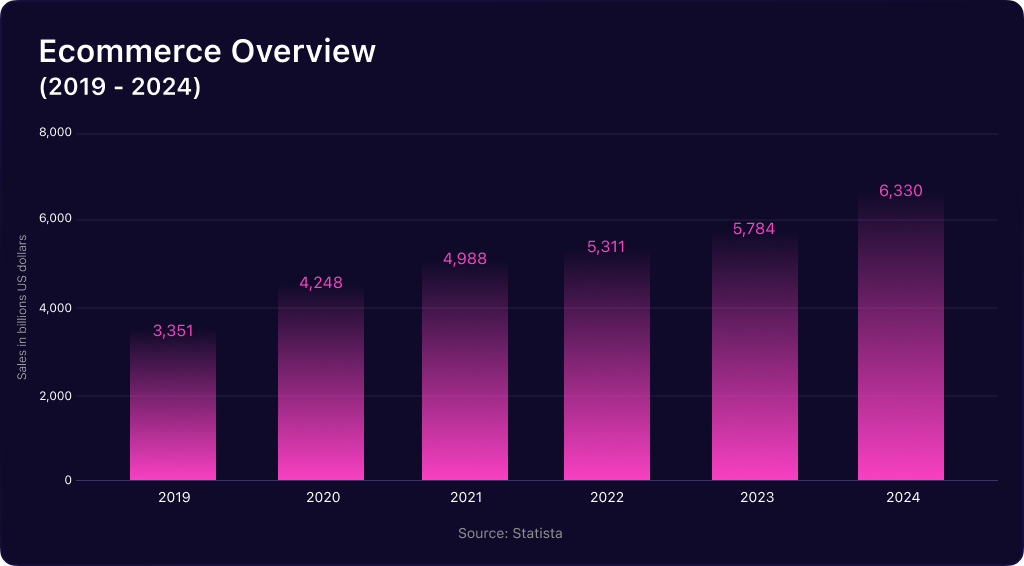
Things are looking bright in North America. The e-commerce market is projected to reach $1327 billion in 2024. And it is not stopping here. It will continue to grow at a 9.09% annual increase over the next few years—reaching $2050 billion by 2029.
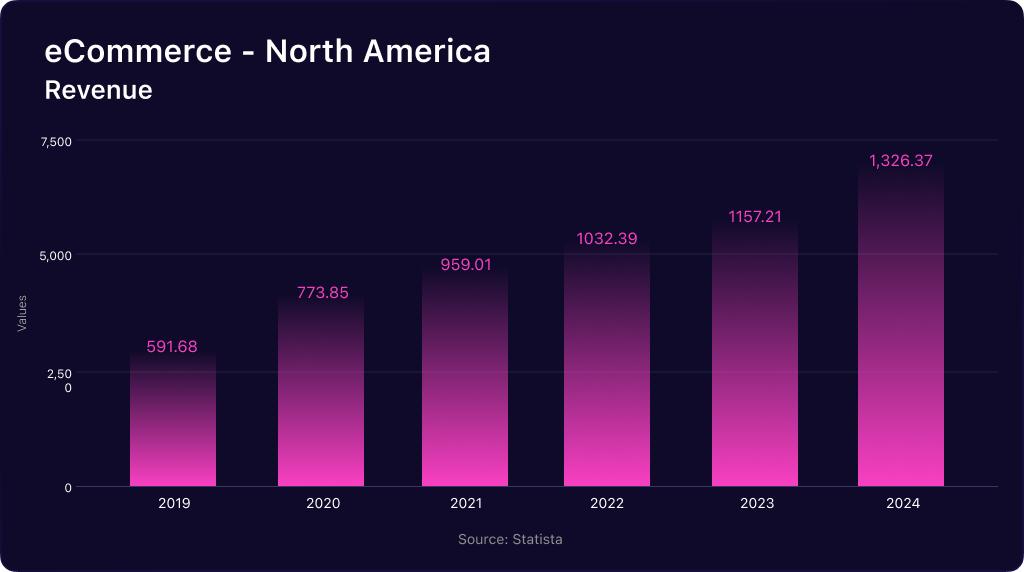
Europe is also seeing immense growth in eCommerce. The market is expected to reach $632.66 billion, and by 2029, it will hit $977 billion. And that is a solid 54.48% growth. So we can say countries like the UK, Germany and France are leading the way as more people embrace online shopping.
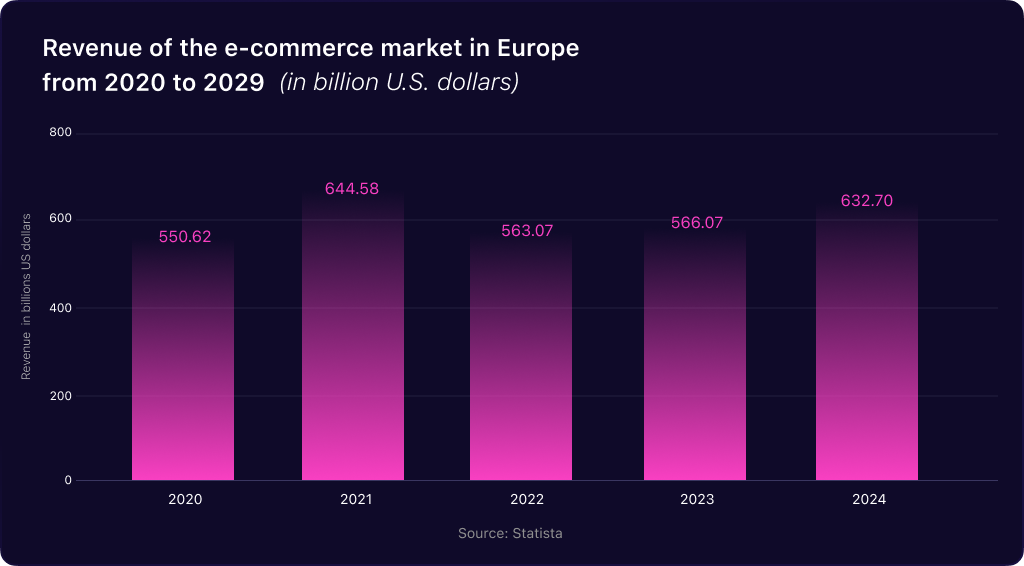
Asia Pacific is also leading the way, with China at the forefront. China is expected to bring in about $1,469 billion in eCommerce revenue in 2024. These numbers are something that all entrepreneurs should watch closely, especially if they are looking to increase sales this Black Friday!
- From Desktop to Mobile: The Shift in Online Shopping
Our research indicates that mobile shopping trends will continue to have a major impact.
That’s because mobile e-commerce has reached a massive $2.2 trillion, making mobile shopping set to account for 62% of e-commerce, with sales hitting $3.4 trillion.
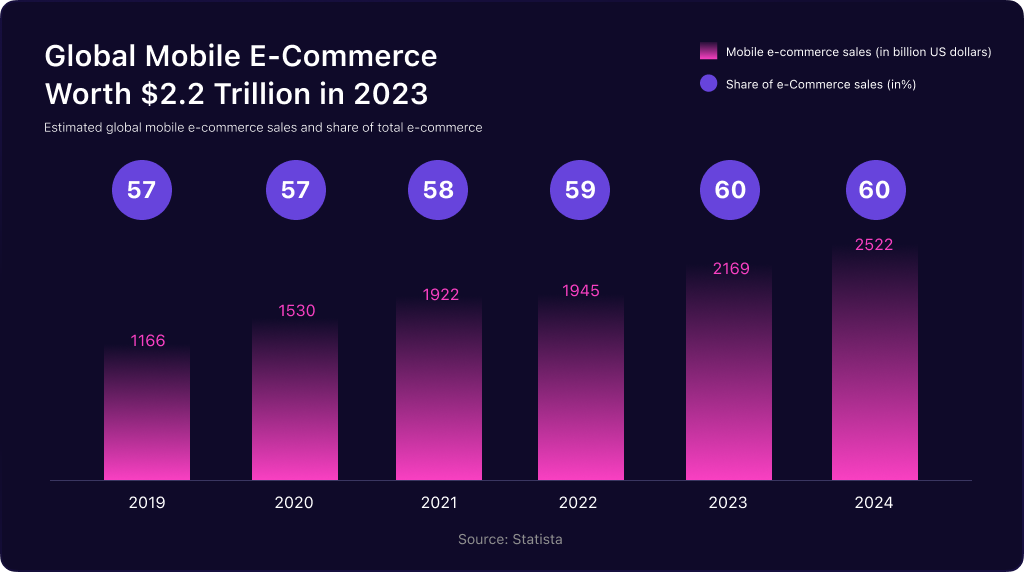
So, what’s driving this chance? It is simple: convenience. People love the ability to shop whenever they want—whether on the move or relaxing at home. This shift is something every e-commerce store owner, marketer, and tech professional needs to take seriously.
- Social Commerce on The Rise
Social media is no longer just for scrolling with platforms like Instagram and TikTok making it easier than ever to shop online and turning into something more than just consuming media.
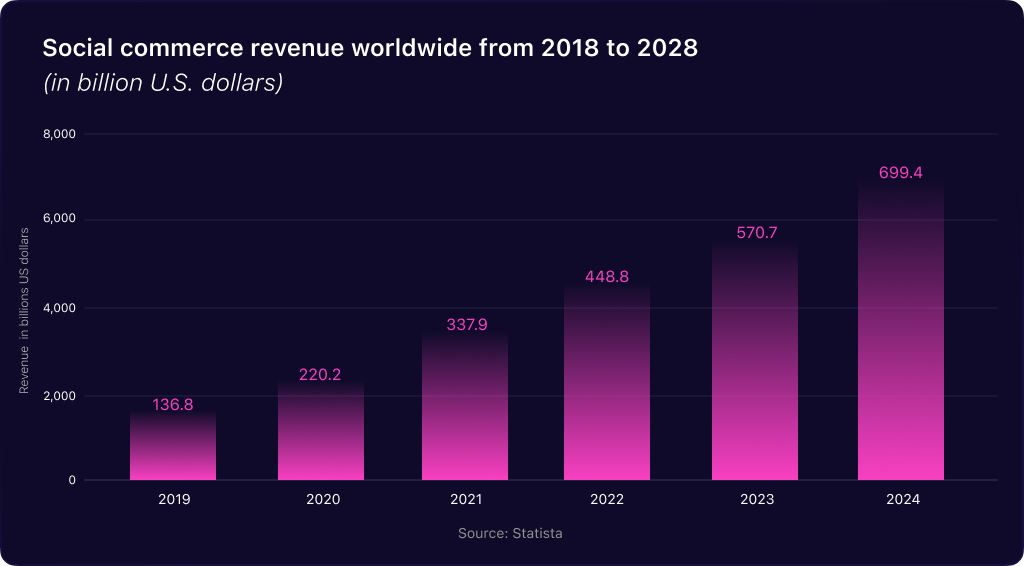
In 2023, social commerce brought in $571 billion USD worldwide, and it is only going up! Experts think it could double and hit $1 trillion by 2028.
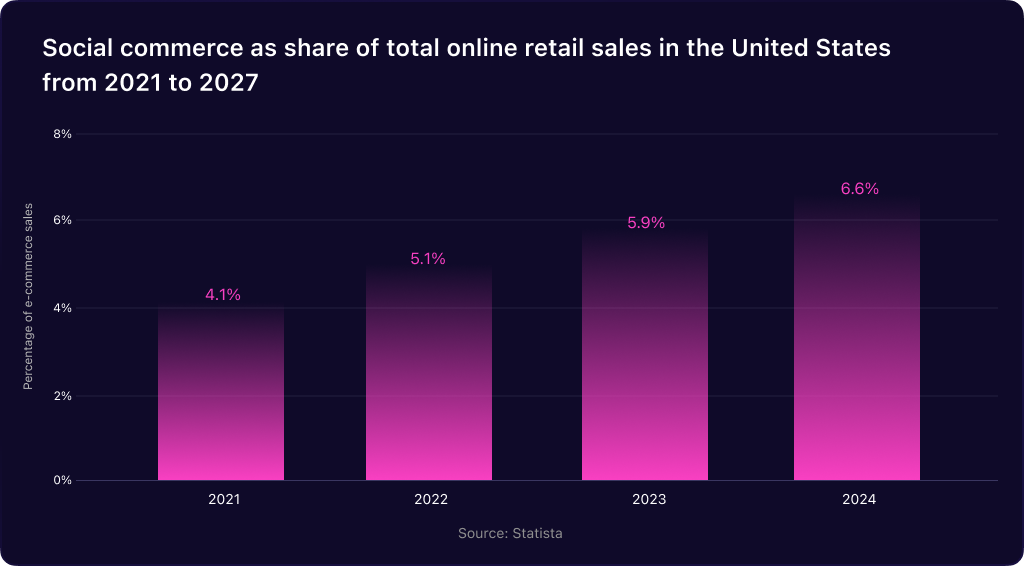
This shift is too big for eCommerce store owners and marketers to ignore.
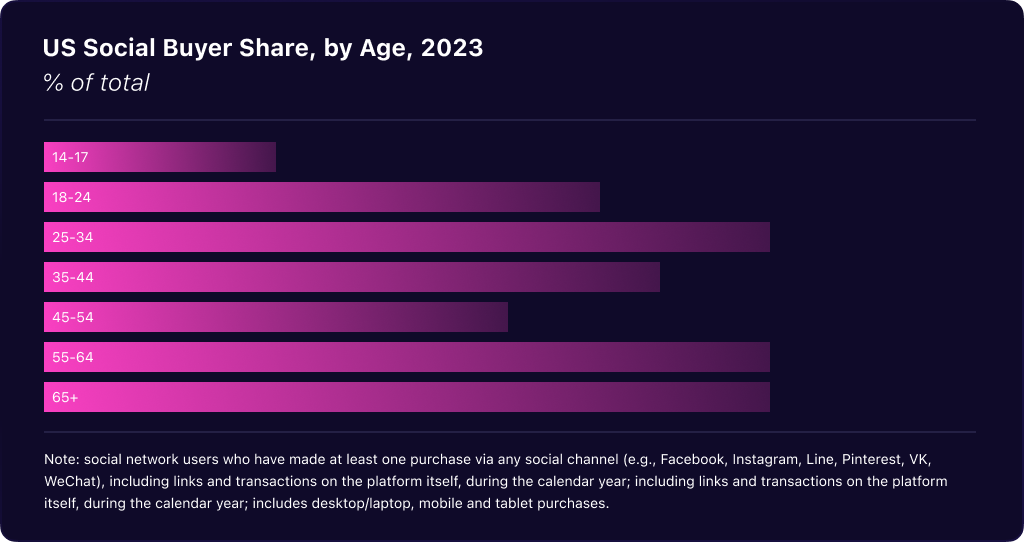
- The Direct-to-Consumer (DTC) Trend
Think about this: you are a shopper who gets to buy straight from your favourite brand, with no middlemen and no extra steps. That’s the magic of DTC — it is a more personal experience. You feel more connected, and the brand feels like it really gets you.
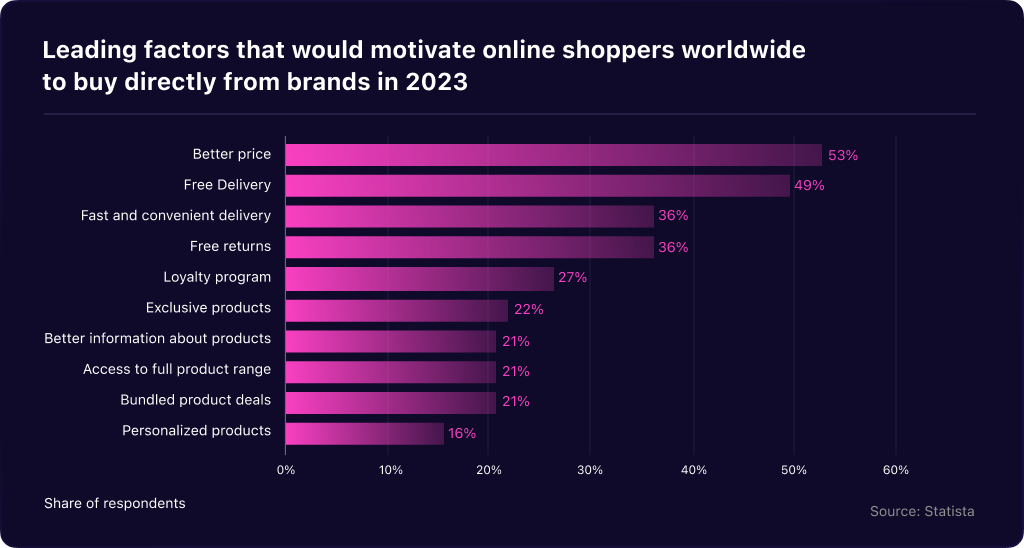
DTC brands are totally transforming eCommerce by connecting directly with their customers. It’s kind of the rage right now, and I get why. It helps bring the brand closer to your audience – and gives you more control over how others perceive the product.
- Total e-commerce market size (USD) in 2019 vs. 2024
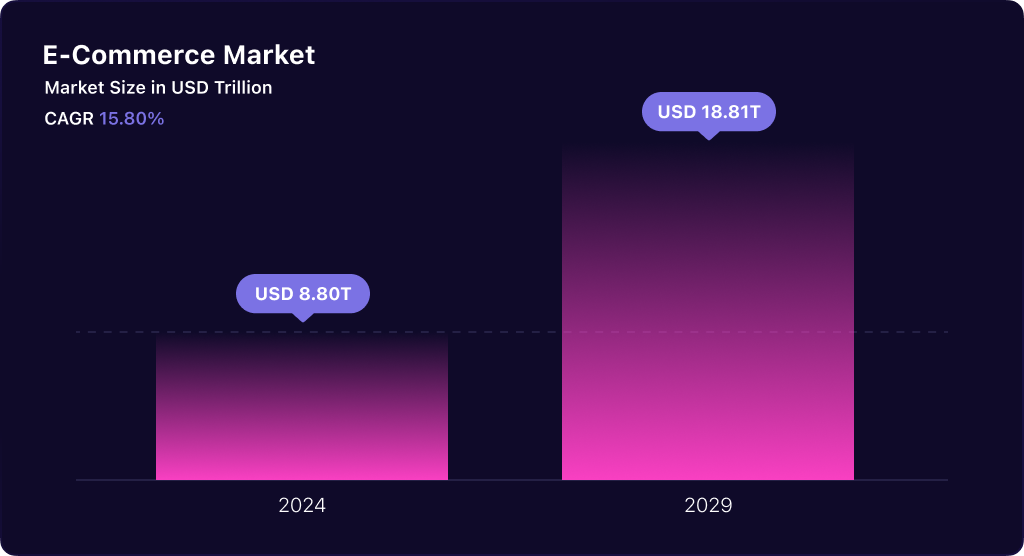
Let’s take a look at how massive the e-commerce market is becoming. Back in 2019, the was already impressive. But fast forward to 2024, and we are talking about $8.8 trillion globally. And it is not stopping there. According to many, it will hit $18.81 trillion by 2029. That’s nearly doubled in just five years—growing at a 15.8% annual rate.
- Percentage of retail sales done online across major countries
Online retail sales, as expected, have increased. Now, the post-pandemic years of 2021 and 2022 saw a stagnancy in sales – with online sales around 18.9% of the total.
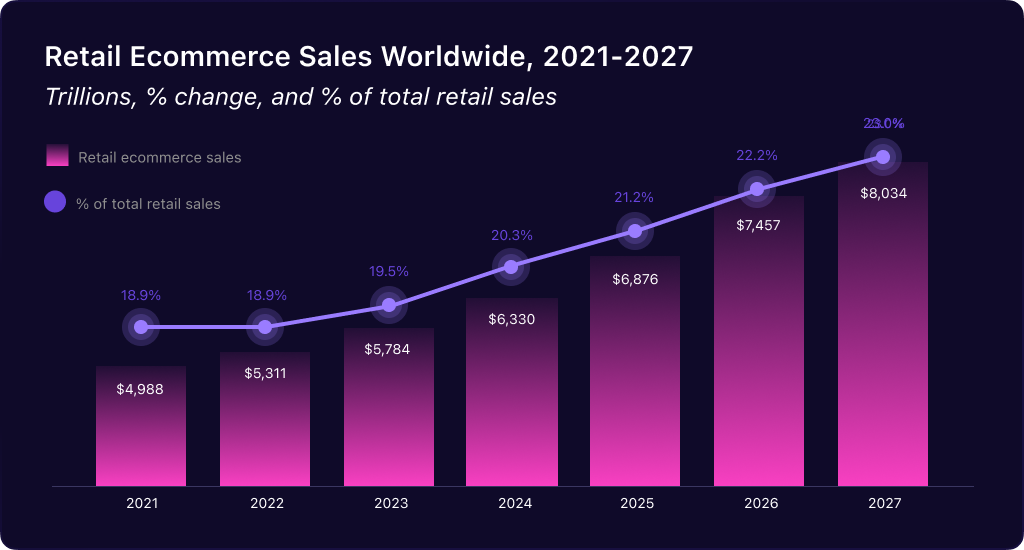
However, this year, we expect online retail sales to make up over 20.1% of the total retail sales and worth over $6.334 trillion USD. That figure will go up to 23% by 2027.
We can see similar rise in US retail eCommerce holiday season sales from 2018 to 2024.
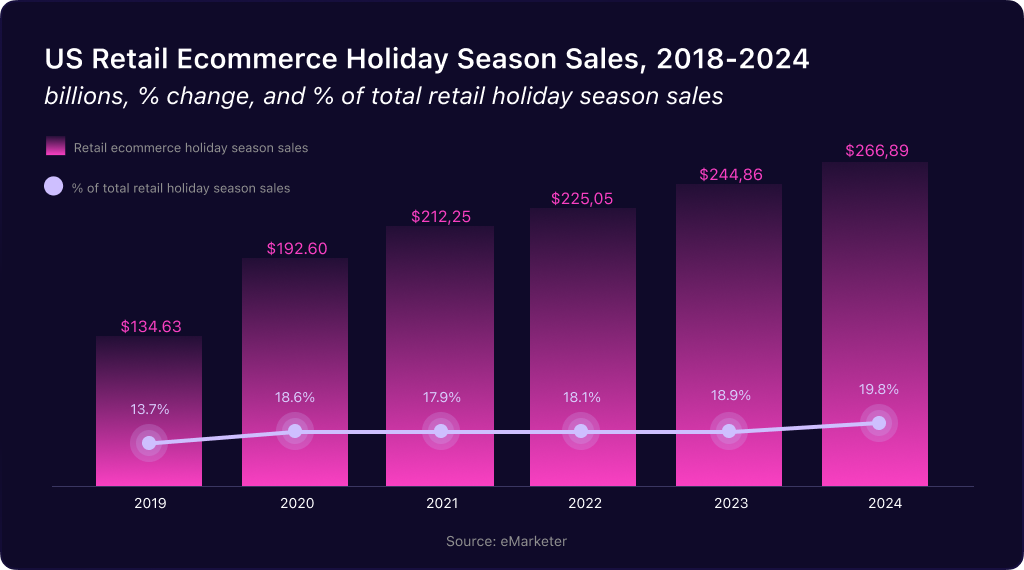
- Mobile vs. Desktop During Sales Trend
Did you know mobile shopping officially took the lead over desktop shopping during Cyber Week? Even a few years ago, mobile conversations barely inched past desktop at 49%. But mobile surged to 53% last year—a solid 8% lead.
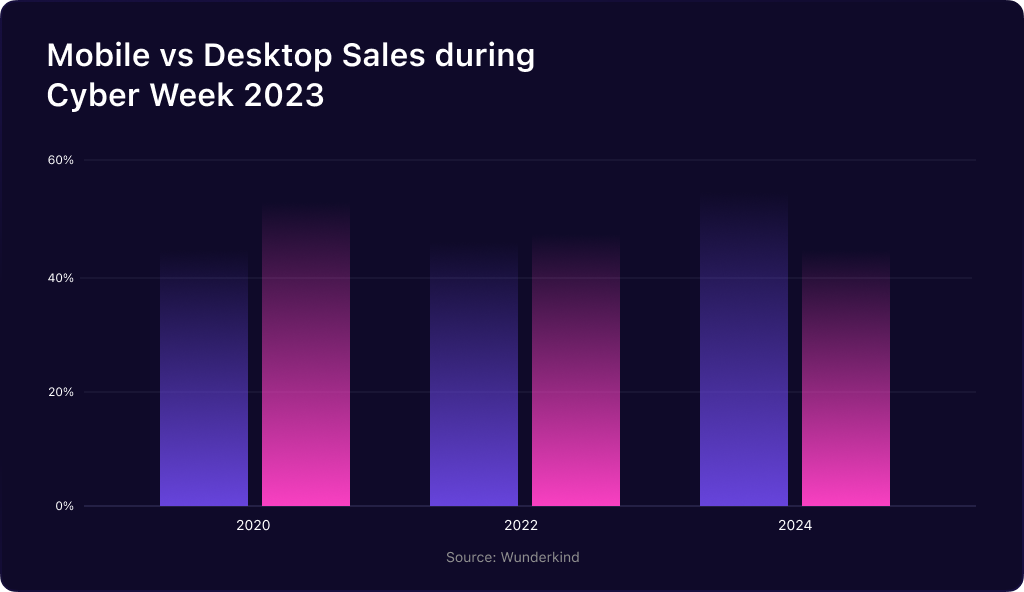
With more shoppers checking out on their phones than ever, retailers need to make sure their websites are mobile-ready. A seamless experience could be key to capturing those valuable Cyber Week Sales.
Shifting Consumer Preferences and Emerging Trends
We also see users interacting with businesses differently. For instance, here are three things we are noticing.
- Subscription models are changing the e-commerce market
Subscription models are growing fast, especially in SaaS and curated products.
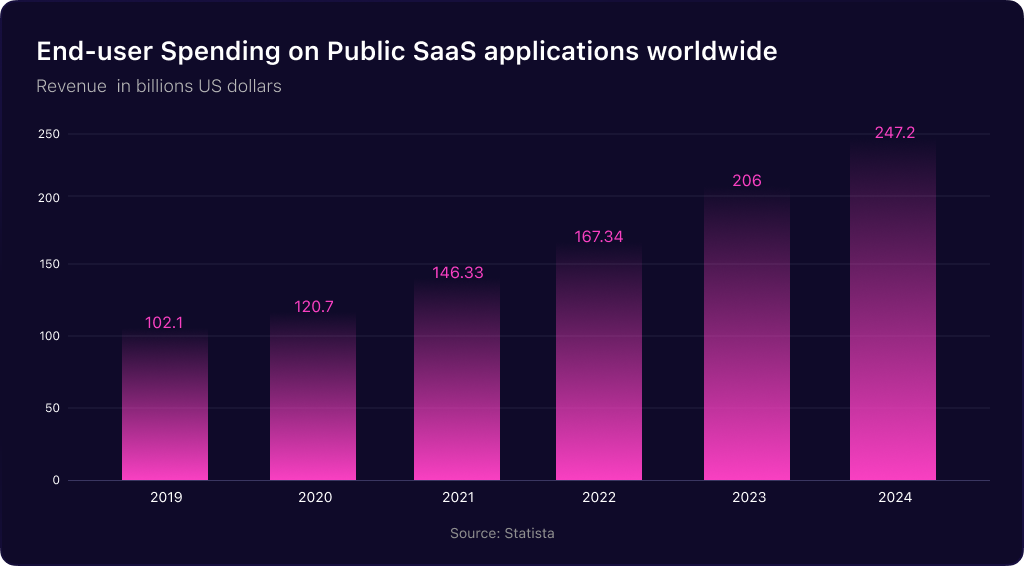
The U.S. subscription hit over $23 billion in 2020 and, by 2023, had generated over $38 billion in year sales — more than double from just a few years ago.
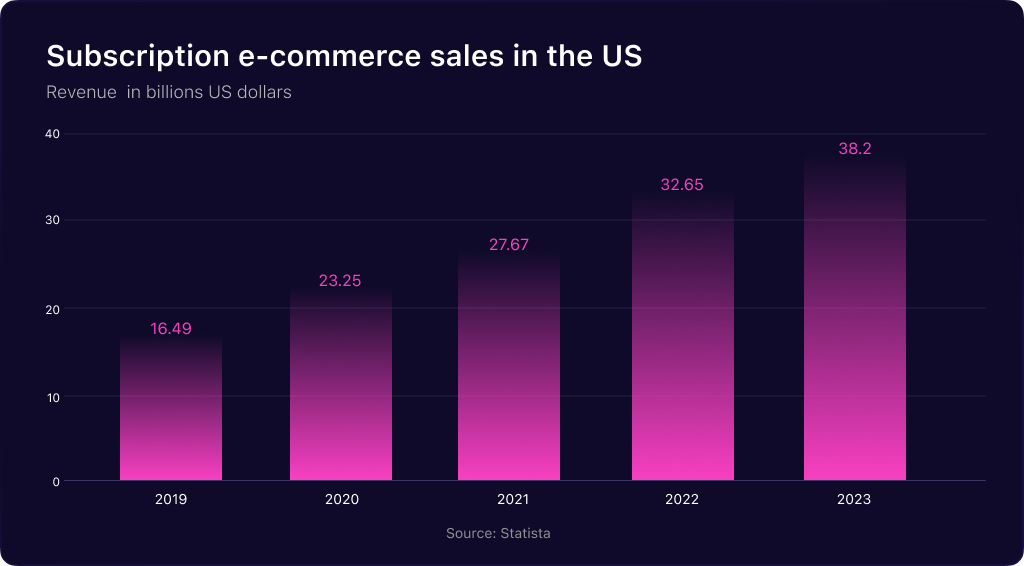
Consumers love convenience and personalisation.
- More people are now more into eco-friendly brands
Sustainability is no longer just a buzzword—it is becoming a top priority for consumers. In fact, products with ESG (Environmental, Social, Governance) claims saw an impressive 28% cumulative growth from 2018 to 2023, outpacing the 20% growth of products without these claims.
More and more shoppers want to support brands that align with their values, ones that are eco-friendly and socially responsible. And if you are not considering sustainability in your business, it is time to rethink your strategy. Consumers are making their choices, and they are leaning toward green!
- Same-day delivery is reshaping consumers’ expectations
Speed is everything these days. Imagine placing an order and expecting it to show up the same day. Well, that’s exactly what more and more customers want.
The global same-day delivery market is only increasing. Three years ago, in 2021, it was valued at around $8.4 billion. And by the end of 2027, it is expected to go up to $26.4 billion USD.
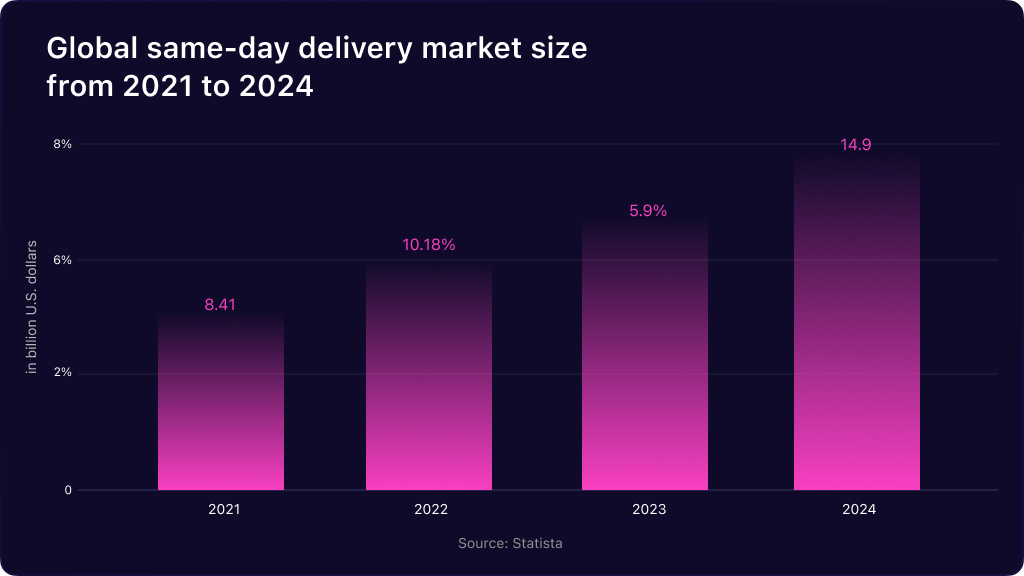
While you can implement tons of strategies to build brand loyalty and customer trust, you need to do what your competitors are doing first. And I think many are focusing on how they can achieve quicker deliveries.
Top eCommerce Strategies Businesses Can Use This Holiday Season
Now that we know the top general e-commerce trends, what can you expect this Black Friday? Rapyd Cloud took a look at the top strategies businesses are using this festive season, and compiled them for you.
Here are my e-commerce predictions for Black Friday 2024 that businesses are using – and what I believe can power your business ahead.
- AI-powered personalisation
AI is transforming how we shop online. Imagine getting product recommendations tailored just for you—this is AI at work! Half of the decision-makers in customer experience are already using AI to analyse feedback and even predict trends and shopping habits by 2024.
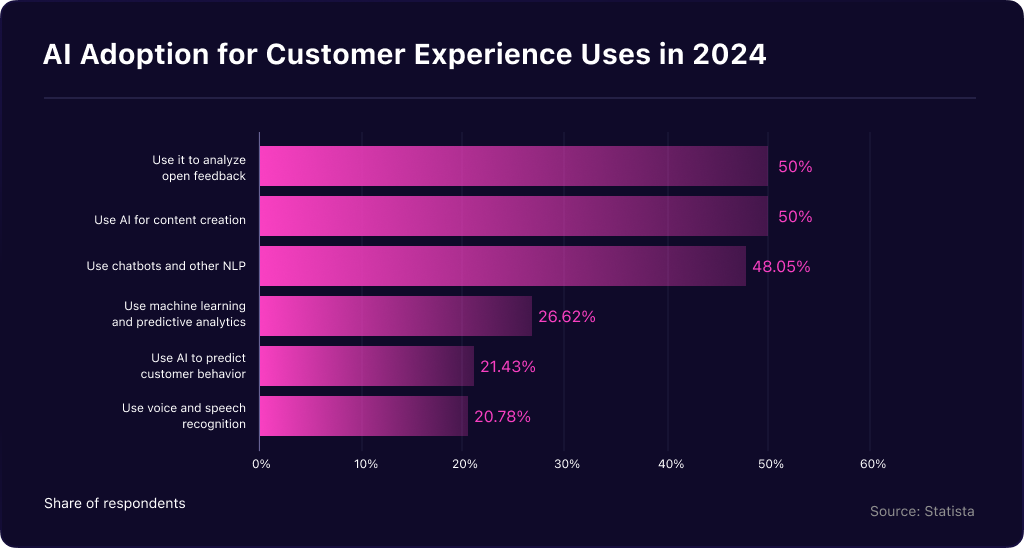
Personalized shopping is no longer a bonus—it is becoming essential. Using AI can mean happier customers who find exactly what they need for eCommerce businesses. More businesses are adopting AI this Black Friday to woo more customers.
- BNPL (Buy Now, Pay Later)
“Buy Now, Pay Later” changes how people pay. In countries like Sweden and Germany, BNPL has now become one of the top payment options. Shoppers love the flexibility—spreading payments over time without using a credit card.
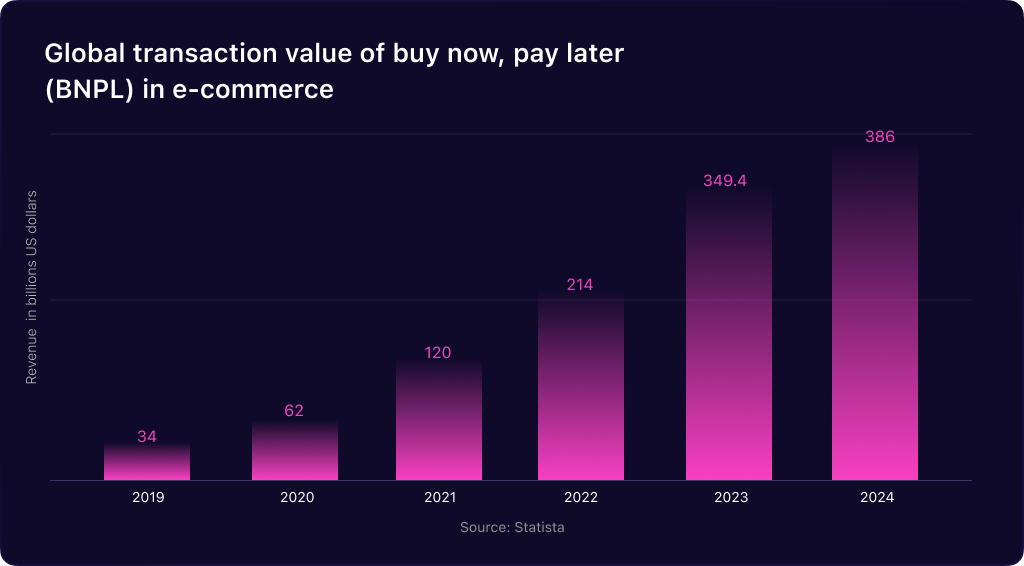
And for retailers? BNPL means more conversions and bigger orders. As customers are more likely to purchase when they don’t need to pay all at once. If you know people are interested in your product, Black Friday presents a great opportunity to increase conversions with BNPL.
- Loyalty programs & their effect on consumer retention
Loyalty programs are not just about points. They are about building connections. 79% of consumers said they bought more often from brands with loyalty programs, according to data in 2022. And that works—70% of U.S. consumers in loyalty programs keep customers engaged, spending more and coming back. For e-commerce, a good loyalty program can turn one-time buyers into lifelong fans.
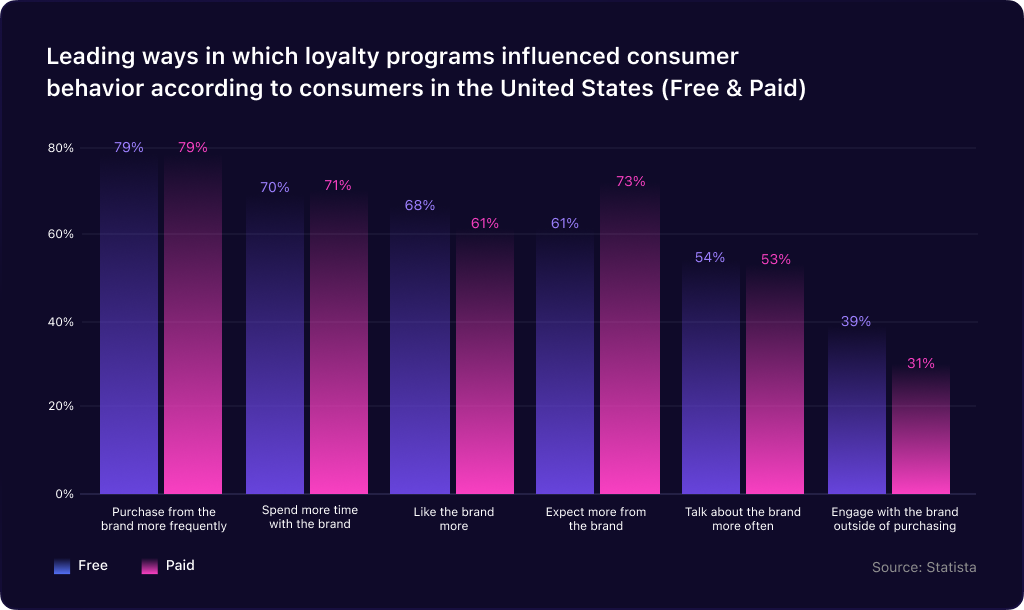
If you’re still in two minds about whether your business should target customers on Black Friday, read on. We are answering a few of the common questions you may have,
Is BFCM’s sales impact growing every year?
Black Friday and Cyber Monday keep setting records! For 2024, online sales during “Cyber Five” (Thanksgiving to Cyber Monday) are expected to hit over $39 billion and $2 billion more than last year.
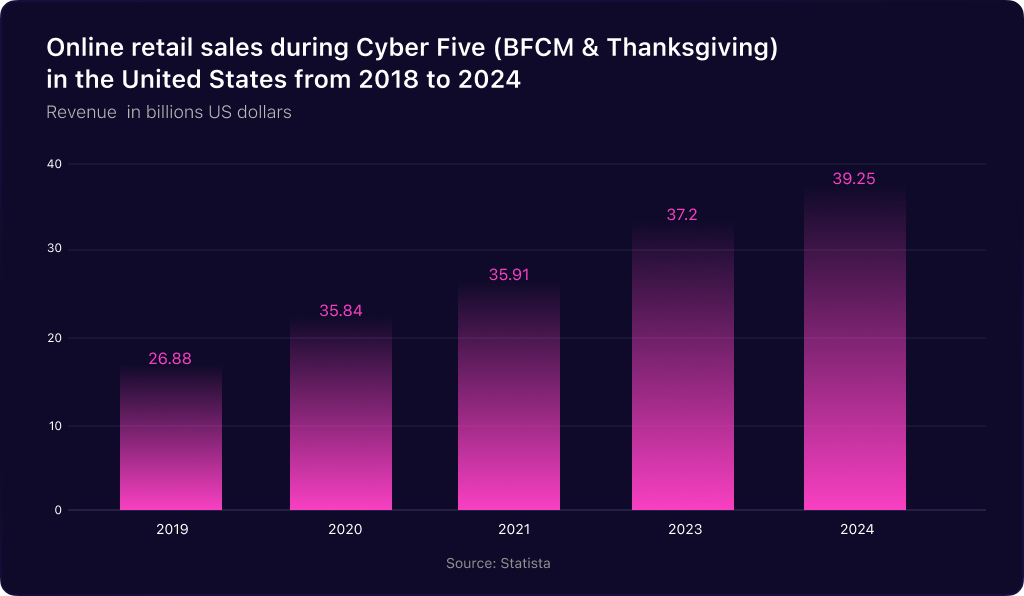
Despite a slow start on Black Friday 2023, European sales also grew 7% over 2022. In short: across North America, Asia Pacific and Europe—BFCM is now a major revenue driver. It has become a powerhouse that retailers can count on every year.
How much of annual sales come from the holiday season?
How much money do you think the average shopper spends during the holiday season? In the U.S. we will see people spending between $957 to $967 Billion USD in the last two months of the year. That’s, on average, a good $875 per customer!
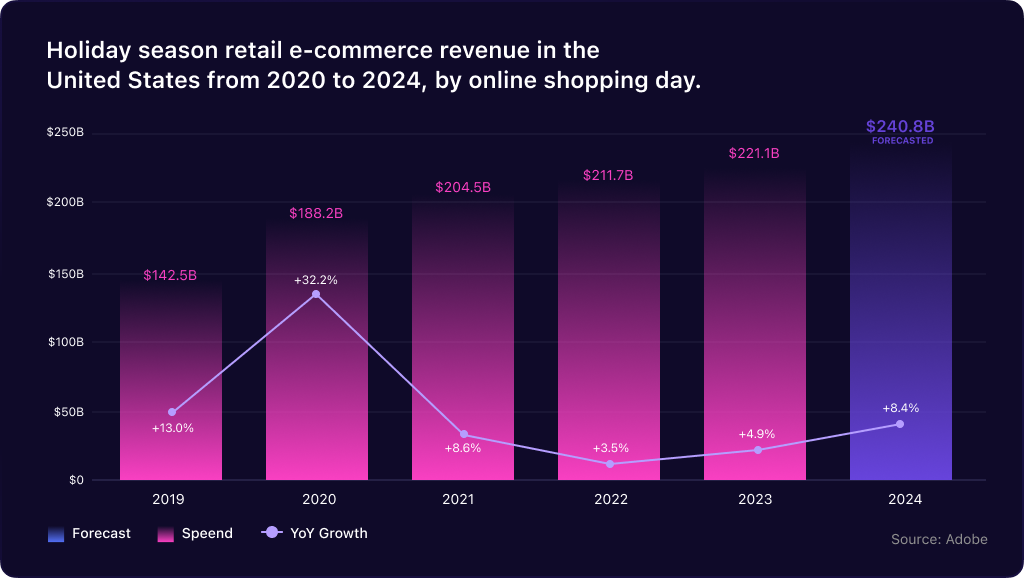
For some shops like toy and hobby stores, the last few months make up over a third of their yearly sales. In fact, for many retailers, holiday sales account for at least a quarter of their total revenue.
This shows us just how essential this season is for e-commerce businesses.
Why does conversion rate matter so much during BFCM?
During Black Friday and Cyber Monday, getting conversions right is everything. Google Ads saw an average conversion rate of 3.75% this year, and Facebook Ads did better at 7.75%. Traditional methods like SMS and email really stand out. SMS had a solid 5.5% conversion rate, while email reached 19%.
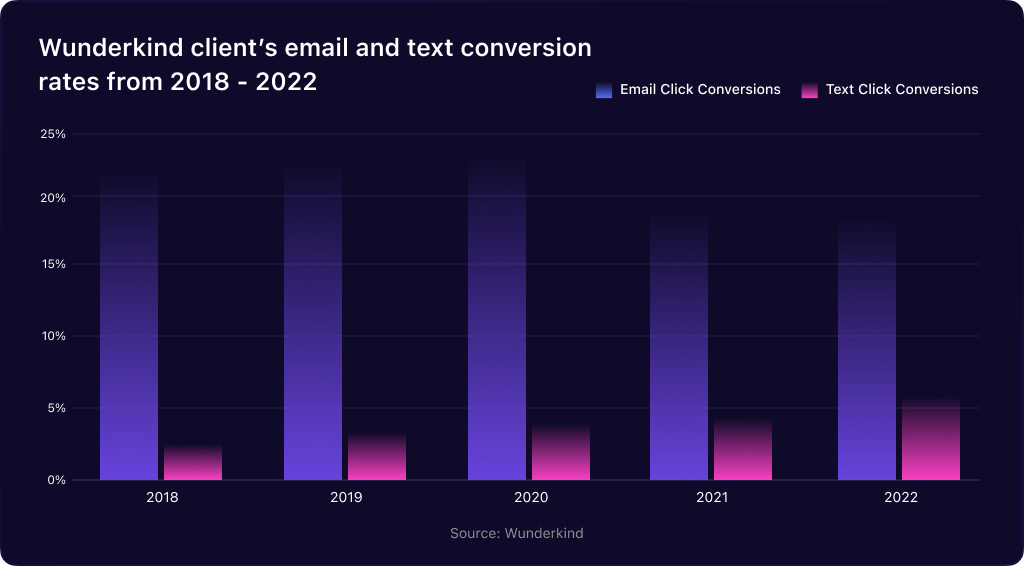
So, to make the most of BFCM, focusing on email and SMS could make a big difference in keeping shoppers engaged. Plus, hiring a web hosting site will also help you have fast and secure websites to handle traffic and prevent cart abandonment during peak times like BFCM!
Black Friday Cyber Monday BFCM 2024: What to Expect
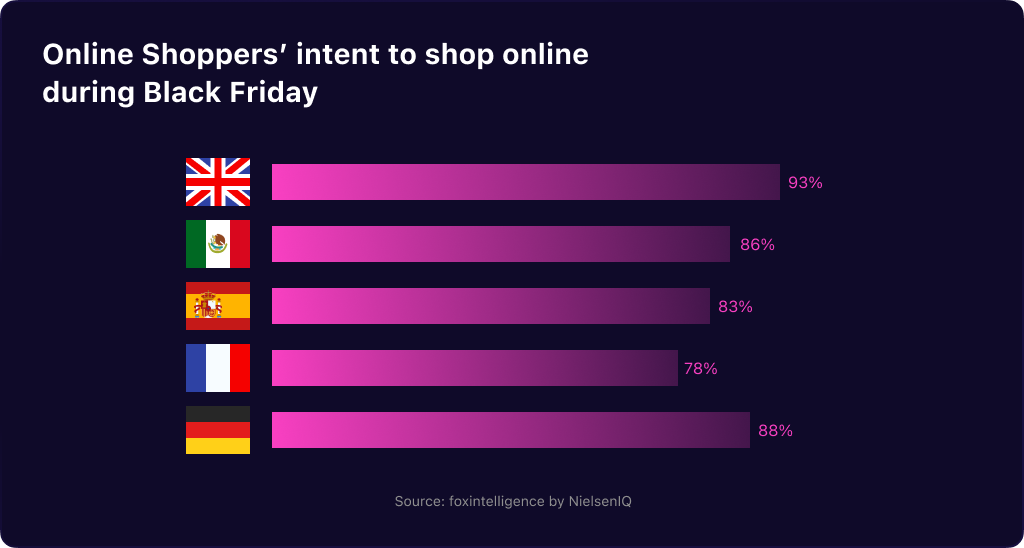
So here we are with the exciting news about BFCM—indeed, things are looking great! And we expect the holiday season to see a 3.0% growth overall, with a huge 9.5% increase in non-store sales, including eCommerce and mail orders.
If you are in the UK, Black Friday is set to bring in £800 million more than last year, a 27% jump! Yes, it is time to prepare for a busy and rewarding season.
Retailers are Going All in at BFCM Deals
From 2020 to 2023, global BFCM sales have increased from $270 Billion USD to $298 Billion USD.
Retailers are getting smarter each year with their strategies for Black Friday and Cyber Monday.
- Early discounts and exclusive offers are the go-to moves for grabbing shopper’s attention early on.
- Personalised marketing and targeted promotions are gaining more success.
- Omni-channel marketing strategies like ‘Buy Now, Pay Later’ are getting more popular.
- Influencer collaborations and a better mobile UX
- Better cybersecurity and fraud prevention measures.
These strategies are paying off big time—especially when you look at how BFCM sales have grown over the last few years! And that’s why, we see:
- The average global order value increased from $121 in 2022 to $127.6 in 2023.
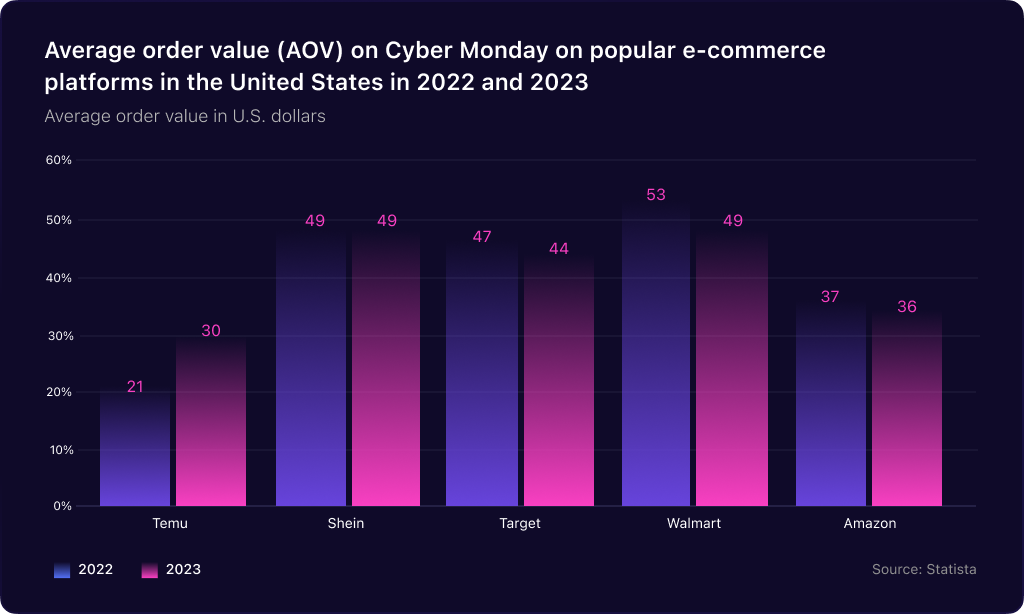
- Home decor and jewelry continues to outperform, with an average order value of $511.7 and $285.5
- We are looking at an even higher average holiday spend of around $1,778, which is an 8% increase year-over-year.
However, we do see a strategic shift in consumer behavior, with customers trading loyalty with more affordable choices. That’s perhaps more because of inflationary pressures, as we will talk about below.
Technological Innovation Is Driving Continued E-commerce Success
So, what are companies doing to enhance customer experience and streamline operations? We talked about personalisation and innovation in e-commerce. It all depends on how you make customers know about you or want to know more about you. You can do that in different ways, like with a Black Friday campaign or creating a customer-centric experience.
- Customer Service Automation
Bots help with everything, from instant answers to better engagement. More Americans are adopting chatbot usage when shopping online, with The New York Post reporting that over 47% use it when shopping online and over 35% when setting up deal alerts.
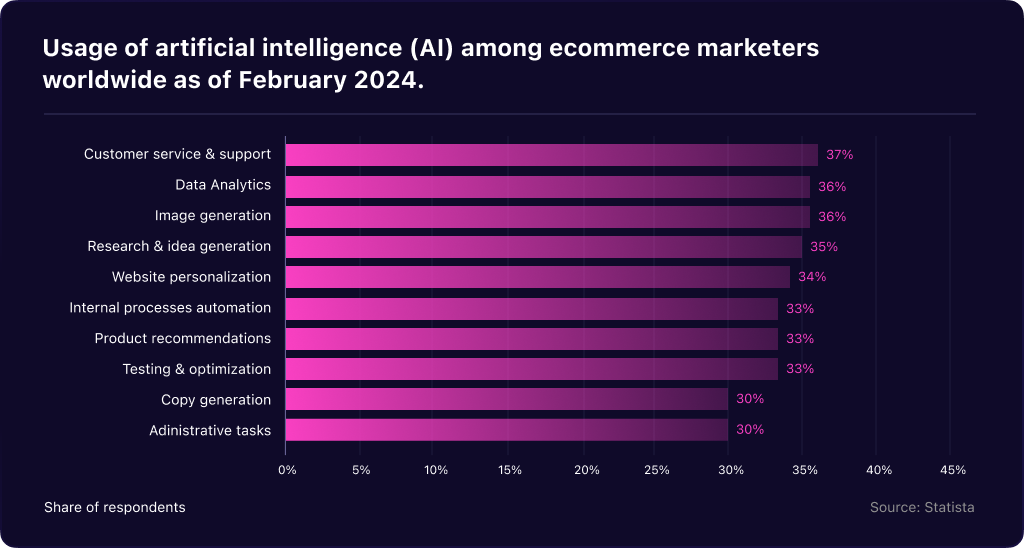
Like last year, during the holiday season, we saw a 10% year-over-year increase in AI-powered chatbot sessions. We don’t believe that should be your only go-to strategy for customer engagement, but customer service automation through chatbots does seem to help brands meet customer needs efficiently.
- E-commerce Platforms and Adoption Rates
Many businesses start with platforms like Shopify, WooCommerce and BigCommerce for their online store. Some of them you can create right on WordPress – like many Rapyd.cloud customers do. They use the WooCommerce WordPress plugin to set up their own store.
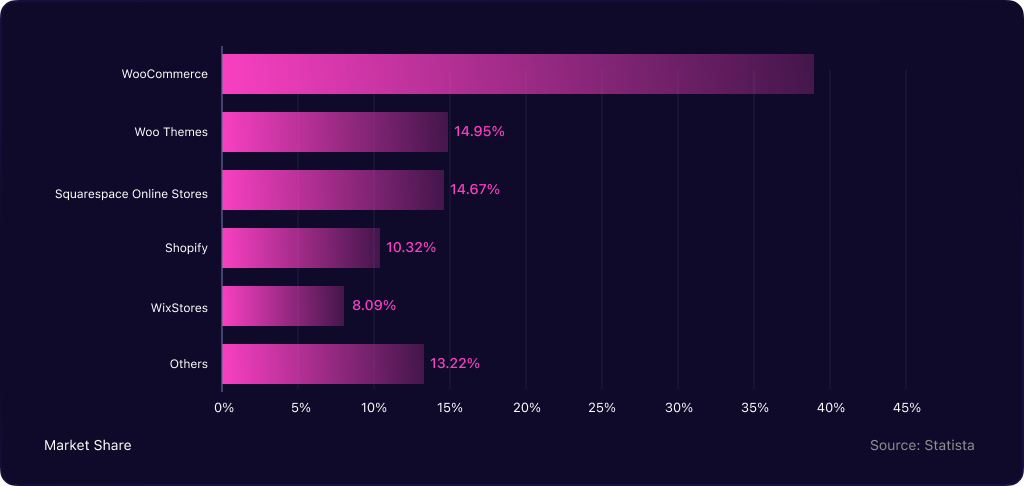
That’s also in part because you don’t need to invest in a separate Shopify plan – your managed WordPress or WooCommerce hosting plan with us has it all covered. Rapyd Cloud WooCommerce hosting plan, for instance, features everything you need for a smooth user experience. We have got everything from CDN, free SSL, Object Cache Pro to backups and more – all included in one single plan price.
- AI in E-commerce Sales
Now, my favourite part. Customers can engage with bots, but they need to feel that you deliver something that they need. And that’s where personalisation comes into play. Fortunately, using A.I. can help you do that – ensuring you show up products and customer flows that can keep them engaged.
They put a brush on the cart but didn’t check out? Have an email sent to them about an offer on their cart item. Did someone browse some coffee cups on your site? The A.I. can check their interests and suggest more relevant ones to them. The possibilities are endless.
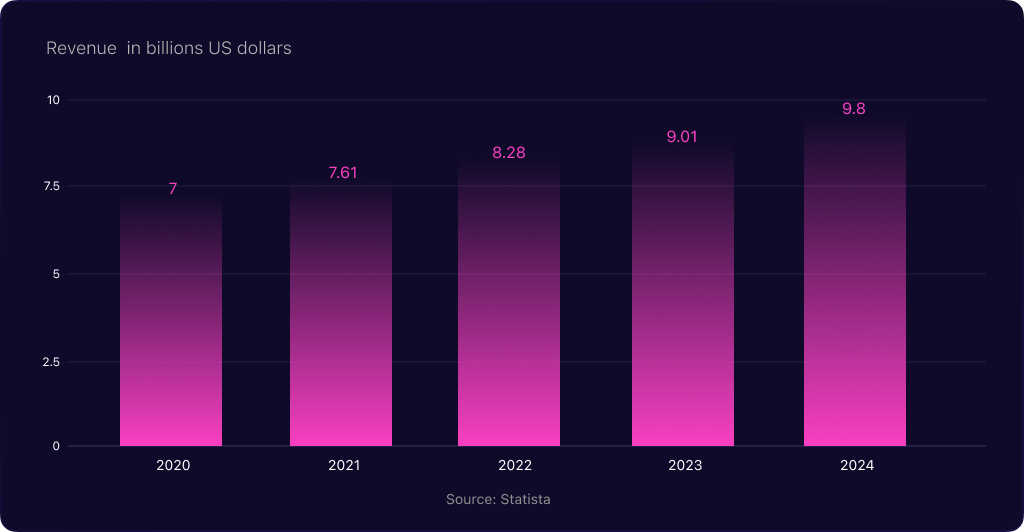
Research by McKinsey, for instance, indicates that businesses investing in AI are seeing a revenue uplift of 3-15% and a sales ROI uplift of 10-20%.
- Market Size of SaaS Tools in E-commerce
Since last year, companies have been adopting SaaS tools much more significantly. I see more businesses looking to use SaaS tools to improve operational efficiency.
And that’s what we have – while the e-commerce SaaS market is expected to reach around $9.4 billion USD by the end of this year, we are looking at an industry size of over $26 billion USD by the end of 2030.
So, when I say we are seeing an increased adoption rate for SaaS tools, I mean it!
Challenges and Risks for E-commerce in the Near Term
The first major challenge would be that we have to be prepared for a dot-com-level bust.
Everyone’s using A.I. – and two things can happen.
- For one, with the increased competition, if you don’t adapt, you go out of the game.
- The other is that the number of SaaS tools in the market will change – not all will survive, especially given changing market conditions.
For your business, it means relying on tools that are effective and reliable and do their job. Additionally, here are some of the other things we need to look for.
- Economic Pressures: Inflation and Recessionary Concerns
Less demand can mean fewer sales. And with inflation surging in the last couple of years, businesses have had it challenging to make sales. In fact, we don’t have to go far back to see this. When inflation surged in 2022, the Average Order Value (AOV) rose by 12.1% compared to 2021.
Some categories were affected far more than others. Health, for instance, saw a 10.3% increase, and grocery grew by 12.1%.
That means a few things:
- Your cost of producing goods is increasing.
- Customers do not want to spend more on the product
- They are, in fact, trying to reduce their spending.
So, the catch-22 for you? You can’t increase prices because of falling demand, while you’re seeing more input costs to your products.
Now, thankfully, inflation is on a downward trend, but you still need competitive pricing to stay afloat. And you can only do that with value-driven strategies.
- Supply Chain Disruptions and Impact on Delivery Times
You want to meet your customer demand – at all times. And while you can have reliable suppliers, you can’t control outside variables – like wars and political disruptions. In 2023, we had a fair bit of that, which created supply chain issues at the peak of the holiday season. This caused the composite rate to surge beyond 200%. That’s not all – spot freight prices tripled during that time.
- For your business, it might mean higher global shipping costs and longer delivery times.
- Customers won’t like their delivery to be late – and this can lead to falling brand loyalty and satisfaction.
- For your business, it might mean the need to diversify and invest in efficient logistics solutions.
- Increasing Competition and Rising Customer Acquisition Costs (CAC)
The number one challenge for your business is to get more customers. And today, we are looking at increasing customer acquisition costs across industries.
Shopify states that these costs can be as low as $21 if you’re in the arts and entertainment industry, or as high as $377 for the electronics niche.
Growing Importance of Cybersecurity
With everything being said about strategies and trends, we have to tell one important thing. If you’ve an online business, you need a robust platform. And I will tell you why – online frauds have been increasing. Every year. From 2020 to 2023, the value of online fraud increased from $17.5 billion to over $48 billion.
As we collect more customer data, protecting customer information is crucial. With Rapyd Cloud, it’s easy to secure your site with our industry-grade malware security, and advanced DDoS protection, WAF and Bot protection.
Future of e-Commerce Beyond 2025: Predictions and Projections
Our eCommerce strategies for the holiday season are simple – future proof your business. And adapt – as needed.
Personalisation will continue to grow – because the use of AI alone will not cut it. While brands will use A.I. to cut costs and streamline operations, it’s about connecting to customers and their needs. As businesses access newer markets, especially across Asia Pacific and Europe, they will also look at newer ways to engage customers.
- Some of them can be done through the metaverse.
- More widely used AR and VR strategies can help customers try on products virtually and experience what it’s like to ‘own’ them first.
- Some businesses may also experiment with drone deliveries in order to reach customers quicker. Dominos, in the U.S., has already started experimenting with it.
- Some believe that drone delivery could become a standard offering for quick, cost-effective shipments in the next few years.
There is another aspect to the mass adoption of A.I. We will see more voice commerce – or where people are buying new products directly with the help of Alexa or Siri. Your business’ integration with smart devices may pave the way for more online sales, as you can continue to build up on customer satisfaction with immersive user experiences.
As Black Friday 2024 approaches, we can see that businesses are looking at refined strategies and innovative technologies. From mobile optimisation to AI-driven personalisation, businesses have multiple avenues to reach and engage their audiences effectively.
If you want to survive, you need to prioritize customer experience, security, and efficient logistics to stay competitive. At Rapyd Cloud, we have some of the best tools for you to achieve that. And this Black Friday, we have our own exclusive deal that you might just want to look again at!


